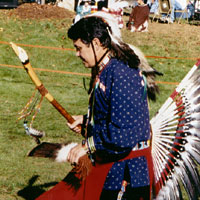 |

傳統舞者:坎帝(Dean
Canty)
1999年11月

|
 |
|
 |
Yap Ye Iswa (卡托巴族日)
地方性遺產
卡托巴族印地安人曾定居在南、北卡羅來納州境內的卡托巴河附近。17世紀時,意為「河邊居民」的卡托巴族,人數尚有5,000名,但到了20世紀末時,卡托巴族的後裔只剩下約1,200人,他們住在南卡羅來納州的羅克希爾周圍。最後一位會使用卡托巴語的人名叫紅雷雲(Red
Thunder Cloud),他是一位歌者及說故事的人,於1996年1月過世。
由卡托巴文化保存計畫所策辦的Yap
Ye Iswa (卡托巴族日),於每年感恩節後的那個星期六舉辦,旨在頌揚卡托巴族的傳統。卡托巴族透過這個節慶來表彰他們的文化,並與擁有不同背景的人一起分享他們的傳統。
節慶一開始就是由河靈(River
Spirit)鼓樂團所表演的召喚歌,歌曲演奏的同時,則伴隨著內有部落戰士、舞者及鼓手的大進場(Grand
Entry)。大進場後,好幾個部落鼓樂團打著鼓,部落舞者則同時表演傳統的卡巴托舞蹈。現場還有根據卡巴托民間傳說改編而成的布偶秀,以卡巴托語演出,另外,他們也會透過錄影的方式,向他人介紹卡巴托的文化。
The Catawba Indians used to inhabit the territory around the Catawba River in North and South Carolina. In the 17th century the Catawba, which means "people of the river," numbered about 5,000, but by the end of the 20th century there were only about 1,200 descendants of the Catawba, who lived around Rock Hill, South Carolina. The last known speaker of the Catawba language, Red Thunder Cloud, a singer and storyteller, died in January 1996.
The heritage of the Catawba is celebrated by the Catawba Cultural Preservation Project, which holds a festival every year on the Saturday after Thanksgiving -- Yap Ye Iswa (Day of the Catawba). The festival is a way for the Catawba to celebrate their culture and share it with people of all backgrounds.
The festival begins with a calling song performed by the River Spirit drum group with the Grand Entry of tribal veterans, dancers and drummers. After the Grand Entry, various tribal drum groups play while tribal dancers perform traditional Catawba dances. A puppet show based on Catawba folklore and in the Catawba language is presented, as well as video presentations on the Catawba culture.
1/1 頁

關於地方性遺產

|





